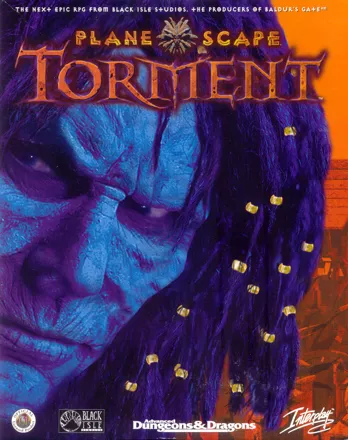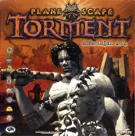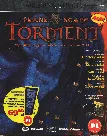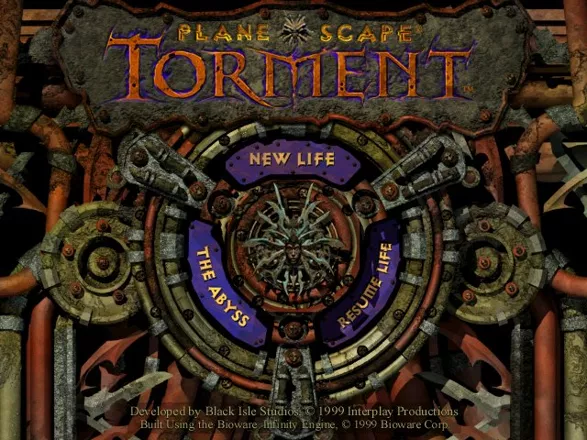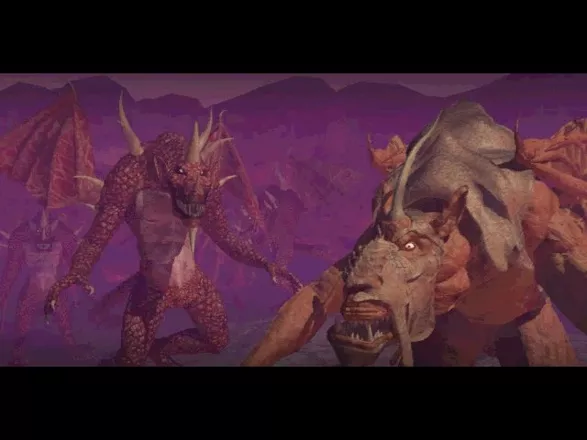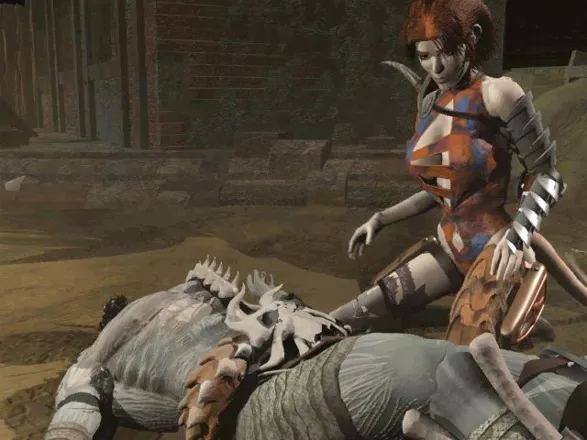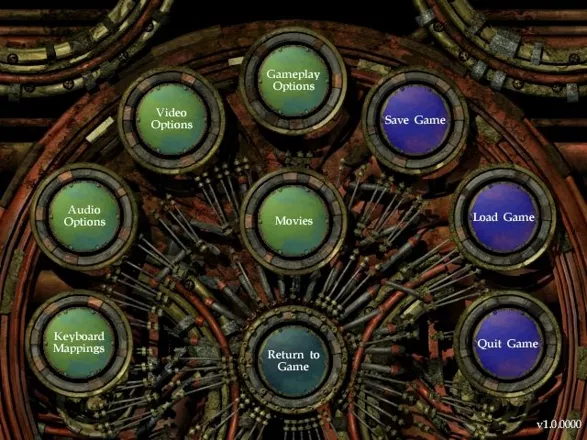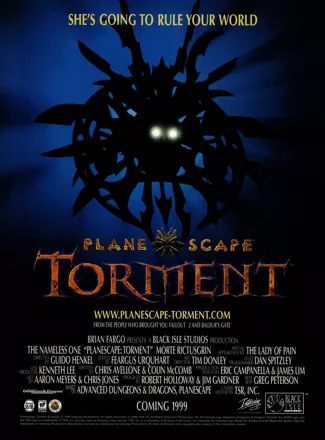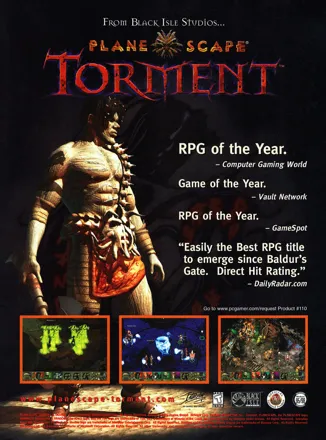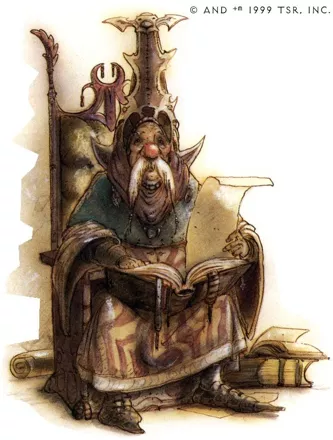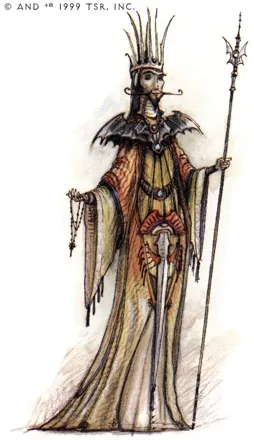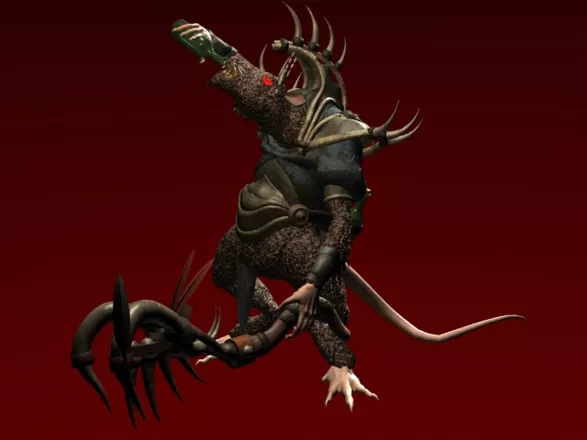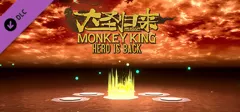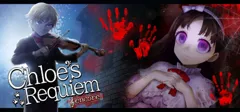Planescape: Torment
Description official descriptions
Waking up on a stone slab in a morgue, which the zombie workers just pushed into the room, a big man with a face deformed by scars, his back marked by strange tattoos, looks at the dead bodies scattered around the room through the dim light, unable to understand who he is. He is sure that he is dead, yet he is also sure that he moves, thinks, and feels. Memories of love, a woman's face, good and bad deeds of his life - all his past appears in a flash, only to be replaced by the dreadful reality of the mortuary.
His journey begins with only one goal: he must learn his name, find out what had happened to him, and which forces prevent him from dying in peace, like all other human beings. The Nameless One opens the doors of the mortuary, only to dive into a world full of fateful encounters, strange characters, broken hopes, despair, and hatred. Piece by piece he shall solve the puzzle and re-discover his own past.
Planescape: Torment is a role-playing game that uses a heavily altered variation of the Advanced Dungeons & Dragons Second Edition rules. It is set in the Planescape, the exotic AD&D setting which is composed out of various "planes" of existence, with unique characteristics to each. The game features the party-based, "real-time-with-pause" combat system which was previously employed in Baldur's Gate.
Character growth is handled via the standard AD&D attributes, which can be raised and modified in the game. Abilities that are not exclusive to combat, such as Intelligence, Wisdom, and Charisma, play a special role in the development and outcome of many of the game's conversations and quests. Dialogue options may become available only if the corresponding character parameter is sufficiently high. The outcome of the final quest and thus the ending of the entire game also depend on the way the player has been shaping The Nameless One during the journey.
Various fairly exotic characters - including a talking floating skull and a winged succubus who runs a "spiritual" brothel - will join the hero on his quest. These characters belong to the traditional AD&D classes of fighter, mage, thief, and cleric. The Nameless One himself starts as a fighter but is able to become a mage or a thief if he meets certain requirements and completes certain quests. The hero is unable to wear armor but can enhance his defenses with special tattoos.
Though combat occupies a significant portion of the game, much of it is dedicated to acquiring experience through exploration of the Sigil, the game's main "hub" town, and performing quests for its inhabitants. The game is notable for containing a very large amount of in-game text and conversation.
Spellings
- 异域镇魂曲 - Simplified Chinese spelling
- 異域鎮魂曲 - Traditional Chinese spelling
Groups +
- Dungeons & Dragons (D&D / AD&D) licensees
- Fantasy creatures: Succubi or incubi
- Game Engine: Infinity Engine
- Gameplay feature: Character development - Skill distribution
- Gameplay feature: Journal
- Gameplay feature: Pickpocketing
- Games made into books
- Physical Bonus Content: Poster
- Theme: Amnesia
- Torment series
- White Label releases
Screenshots
Promos
Videos
Add Trailer or Gameplay Video +1 point
See any errors or missing info for this game?
You can submit a correction, contribute trivia, add to a game group, add a related site or alternate title.
Credits (Windows version)
143 People (137 developers, 6 thanks) · View all
| Lead Programmer | |
| Programmers | |
| Additional Programming | |
| Scripters | |
| Movie Technology | |
| Lead Artist | |
| Artists | |
| Additional Art | |
| Lead Designer | |
| Designers | |
| [ full credits ] | |
Reviews
Critics
Average score: 89% (based on 61 ratings)
Players
Average score: 4.2 out of 5 (based on 372 ratings with 20 reviews)
Does it get any better than this for CRPG's?
The Good
The story. If you want to play an RPG with some intelligence and plot, with just the right amount of fighting, this is the one. A very deep and involving plot (with a LOT of reading), very nicely rendered spell effects, and an excellent interface, all make this one of the best CRPG's around.
The Bad
I don't know if it was just me, but I did not get to a high enough level to even make use of some of my most powerful spells. I finished the game just fine without them, but it would have been fun to try them.
The Bottom Line
This is a top-down (3/4 view) CRPG that takes place in a dark fantasy world derived from the AD&D setting of Sigil, a sort of hub of the universe which has portals that can transport you to various "planes". You play "The Nameless One", who is trying to find out who he is and why he cannot die. His possible companions include Morte, the floating skull, Dakkon, the expert swordsman, and Annah, the sharp tongued, tail wagging, half human/half demon. This is very much an interactive novel with the emphasis on plot development with some fighting/spell casting to spice it up. This is not a bright, cheery game, but there is enough humor interspersed throughout to make this a very enjoyable experience. This is highly recommended.
Windows · by Rodney Mayton (17) · 2002
The best game I have ever played to date.
The Good
Sometimes games can transcend the medium and rise above the level of a pastime relegated to spotty teenagers. This is one of those times.
I am not one to award the title "great" to anything, and only on a few occasions before now have I declared anything the "best" of its type.
But this is the best game I have ever played to date. If this game's contemporary, Ultima 9: Ascension, tells future designers how to make an engrossing 3D world simulation, this game tells designs how to craft a story that is best suited to the medium.
For one, unlike many games of the genre the characters that can adventure with you are crafted -with- the story, not written in to function as pack-mules or combat satellites. When something happens in the game, chances are one of your companions has something to say about it ranging from helpful advice to wry commentary on the unfolding situation. Your companions will continue to play a role in the story even after they have joined the party, quite rare for a game of this type. It works so well it makes me wonder why it isn't done more often.
This is the only game I have seen to this day that differentiates between a honest-to-god threat and bluff, and vow between a lie. Not only to words have meaning, so do the meaning behind those words. On a similar note this game possesses some of the best written dialogue I have seen anywhere, not since Ultima 7 has even the most inconsequential character been so well written.
Some AD&D purists might not like the fact that the game plays pretty fast and loose with the rules. Maybe they would be happier with Baldur's Gate, in my opinion the most overrated game in the last few years. In P:T the rules serve as a backdrop, not a backbone. In that way this game, though single-player only, feels more like a good pen&paper session with an experienced DM than any CRPG I have ever played.
The Bad
The manual is justifiably skimpy on details about the game setting and historical information. Considering your character plays an amnesiac it would be inappropriate to include a Planescape Campaign handbook with the game. However, the manual is absent of any information regarding the way the rules work, considering that the game is based on the AD&D ruleset this seems almost unforgivable. While the game is still playable without understanding what your THACO actually means, it does detract in minor ways from the playability.
The interface is a little clunky, though I did get used to it soon enough and it never really hindered gameplay.
In the unpatched version of the game there are a few minor dialogue bugs involving the improper resetting of conversation trees, but no plot stoppers to speak of. One technical issue that does deserve mention is that when the game has been running for more than a few errors most players experience a game-killing slowdown. Although there are a number of temporary fixes for the issue the only real way to get around it is by saving and restarting the computer. Annoying, but infrequent enough that it is only that, an annoyance. At the time of this writing there is no patch to correct this issue, but Black Isle Studios has promised that one is forthcoming.
The Bottom Line
An excellent adaptation of the TSR Planescape Multiverse and a wonderful example of how to tell a story with an interactive medium.
To speak too much of the story itself would be a crime, suffice to say that your character awakes on a slab in a Mortuary in a strange city with no memory to speak of. From there he embarks on a quest to discover himself and learns about the nature of man.
Windows · by Patrick Mills (36) · 2000
I don't think we're in Faerûn anymore, Morte ...
The Good
Amnesia in today's role-playing games has become little more than an over-used cliché to create blank characters on which players can project whichever personality they wish, but which nonetheless have a past that's relevant to quests and NPCs. Off of the top of my head I can name only two RPGs in which the cliché works as a plot element, one being Knights of the Old Republic, the other Planescape: Torment.
Planescape's major feat is combining the time-honoured AD&D rules with a setting and characters that are amazingly original and deep. Players are presented with a world that appears to the main character as alien as it must have appeared to lovers of classic high fantasy when they first opened the Dungeons & Dragons Planescape campaign box.
Waking up on a slab in a gigantic mortuary, players are hit with some rather surprising facts about their existence: one, they were dead; two, they can't be too sure whether or not they still are; three, their memories of what brought them there are gone and four, apparently somewhere along the way they befriended a floating skull who pleasurably gives the hero what little information he is to be provided with to start his quest. The macabre miracles don't stop there because not only must the walking corpse flee the mortuary run by a slightly disconcerting group of people nourishing a philosophical death wish, upon stepping out into the streets the nameless hero, appropriately named Nameless One for the entire game, discovers that he is in Sigil, the City of Doors and easily the most unusual place in the entire AD&D multiverse. Being the hub of a cosmological wheel on which all possible worlds in the Advanced Dungeons & Dragons universe are located in the form of dimensional planes, Sigil appears to possess the inherent trait of randomly opening magical doors to said worlds and attracting its inhabitants. The potential for literally outlandish characters which bring a plethora of personalities, backgrounds and quests to Torment's rich story is nigh unlimited and used to almost full effect by the creators.
Everyday little wonders can be found at every corner and its a credit to the game's sheer narrative power that the vast majority of odd episodes play out almost entirely as text box descriptions. Dialogue in Torment is elaborate and incredibly well-written; at the time of its release it easily beat the until then wordiest RPG, Baldur's Gate. The game's strong focus on personalities and intellectual problems very elegantly steps in the way of this becoming a chore. Battles play an inferior role in Torment and can often be evaded altogether using the game's equally developed and elaborate dialogue options. In short: Planescape is one of the wordiest games ever, waking memories of old Infocom text adventures which captivated gamers' imaginations like good fantasy novels do. Torment achieves exactly that.
Torment's main cast is one of the strongest and most colourful in any RPG created to date. Whoever thought Final Fantasy holds the monopoly on quirky and unusual party members needs to play this game. Where else does an undead hero team up with the already mention floating, Billingsgate-talking skull who equips dentures like weapons, a half-demon street thief, an honour-bound mystical warrior, a succubus and ex-proprietor of a platonic brothel, a robot looking like a walking TV set, an eternally burning arsonist wizard or an animated suit of armour?
Based on the Infinity Engine already used in the Baldur's Gate and Icewind Dale series, Torment's graphics are presented in Black Isle's standard isometric view. Running at a resolution of 640x480, the game's detail level benefits from larger onscreen sprites and a closer look at the morbid scenarios. Thanks to a freely placeable actions menu that can be displayed and hidden with a right-click, the screen layout feels a little less cramped than in Baldur's Gate and allows for a literally broader view of the world.
Torment's music is appropriately odd, mixing minimalist and experimental tunes with mysterious melodies just unusual enough to never let players forget that while they're still playing a fantasy game, a classic AD&D campaign this ain't!
The Bad
For players with the right mindset Torment is an almost perfect RPG experience and its shortcomings are mostly matters of personal taste.
Unfortunately, its greatest asset, the captivating text descriptions and dialogue, make the game inaccessible for casual gamers or those who don't feel like wrapping their minds around an exceedingly fantastic and macabre world. The game decidedly (and rightly!) closes the door in the face of people who are unwilling to read the equivalent of a fully-fledged fantasy novel onscreen.
The graphics, while bigger and clearer than in other Baldur's Gate-related titles, restrict a larger view of the scenarios by limiting the game to a single resolution, 640x480 - pretty low by today's standards, considering that unlike Baldur's Gate even the action panel to control characters can be freely moved and hidden when desired. In addition, character models, although detailed and well animated, are static in terms of design. Almost no equippable item changes anything about the models onscreen appearance.
AD&D fans will also miss the possibility of building a custom party of adventurers. As versatile as Torment is in terms of scenario, it is far more linear than most other AD&D game when it comes to character development and customisation. Only the main hero can equip different weapon classes based on his chosen profession and it isn't possible to choose from all professions the AD&D rules have to offer. The Nameless One can be either a fighter, wizard or thief, but always looks like a buff warrior type even if his stats and chosen profession say otherwise.
Exploring Sigil and its inhabitants is one of the greatest joys I've ever had in an RPG. It is almost a pity that after three fourths of the game players are ripped out of the by then familiar surroundings. While the game builds to a climax they are forced to travel to other, significantly smaller and more linear planar worlds.
The Bottom Line
Planescape: Torment is one of the most unusual, original and rewarding RPG experiences to date. It requires and tries players' patience and imagination but repays them many times over if they are up to the task. The game exists and entertains through its deep and lyrical understructure, making its lack of character customisation excusable.
All seasoned gamers looking for a fantasy tale far, far away from the genre's stereotypical elves, dwarfs and humans vs. orcs stories must play this game.
Windows · by Kit Simmons (249) · 2008
Discussion
| Subject | By | Date |
|---|---|---|
| Advise | Indra was here (20756) | Nov 6, 2010 |
| Some new revelations. | The Fabulous King (1332) | Sep 29, 2007 |
| For you Tormented souls | DJP Mom (11333) | Aug 13, 2007 |
Trivia
1001 Video Games
Planetscape: Torment appears in the book 1001 Video Games You Must Play Before You Die by General Editor Tony Mott.
Add-ons
For both St. Patrick's Day and Easter of 2000 the developers released a pair of character add-ons: Leprechaun Annah and Eastern Egg Morte. These change all the graphics and animations for said characters and, in Morte's case, add new sound samples that were left in the cutting room.
Cover
So who is the guy that appears in the box covers and ads as the Nameless One? Game director Guido Henkel himself (with some heavy makeup and after some digital post-production of course).
Cut content
One feature that didn't make it into the game from the vision document was the ability to change the character's smell.
Cutscenes
In the initial concept for the game the title screen menu was to have an additional tab for viewing the cinematics. Though it was removed for reasons unknown it still made its way into some manuals which state the title screen should have a "Visions" tab for movies.
Development
The creator of the Planescape campaign universe and former TSR creative guru himself Zeb Cook, contributed to the creation of the game along Colin McComb, (who took the Planescape banner at TSR when Cook left), and Guido Henkel, designer of the Realms of Arkania series.
Language
Morte If one is to believe a certain motion-picture-like print ad that ran in late 1998 (you know, the ones that go "so and so present a so and so production starring...") you'll find that Morte's last name is "Rictusgrin".
Music
The music that plays in the Civic Festhall is from the 2nd movement of Vivaldi's concerto for two oboes in D minor.
Novel
There is a novel based on the game written by regular Planescape suplement writters Ray Vallese and Val Vallese. The novel was later included for free with copies of Planescape: Torment when bought from the Interplay Store. A soundtrack CD is also available.
Trailer
There is a promotional trailer for the game featured on earlier Interplay titles like Baldur's Gate (NOT the one featured in the game's page and which includes gameplay shots), that includes completely unseen CGI footage that doesn't appear in any of the game's cutscenes. The trailer shows, among other things: the Lady of Pain floating around, Nordom in the Modron Cube, the Iron Golem roaming a forest, the Nameless One at his tomb, Hargrimm casting a spell, Ignus being consumed (probably his origin?) and several other creatures plus many POV sequences which show places and scenery (you know, the ones that get triggered when you first travel to some location). Rumor has it that this is actually a mix of sequences made solely for promotional purposes and stuff that was cut out of the game for space considerations. In any event, save for a part of the shadow world intro, this is all unseen stuff.
Awards
- Computer Gaming World
- March 2000 (Issue #188) – Role-Playing Game of the Year
- March 2000 (Issue #188) – Best Character of the Year (for Morte)
- March 2000 (Issue #188) – Best Art Direction of the Year (for Morte)
- October 2004 (Issue #243) – Introduced into the Hall of Fame
- GameSpy
- 2001 – #45 Top Game of All Time
- PC Powerplay (Germany)
- Issue 06/2005 - #2 Likeable Secondary Character (for Morte)
- Issue 11/2005 - #3 Game Which Absolutely Needs A Sequel
- Issue 12/2006 - #8 Hype Disappointment (the number of sales was disappointing in relation the quality of the game)
Information also contributed by Adam Baratz and SDfish
Analytics
Upgrade to MobyPro to view research rankings!
Related Sites +
-
Alphabetti Spaghetti: Planescape Torment - Fully Modded!
A complete, step by step guide to installing, patching and modding the game for WinXP systems. -
Bootstrike.com - Planescape Torment
Has walkthroughs, downloads, cheats and lots of cool stuff, including the story of Planescape Torment. -
Hints for Planescape: Torment
Excellent question and answer type hints to help you solve the game without spoiling the whole thing for you. -
Matt Chat 63
Video interview with Chris Avellone about the development of Planescape: Torment -
Planescape: Torment Fix Pack
An unofficial Fix Pack that fixes many bugs in Planescape: Torment that were not fixed by the official 1.1 patch. -
Planescape: Torment Walkthrough
A walkthrough of the game -
Planescape: Torment website
Official Planescape: Torment website, archived at planescape.outshine.com -
Planet Baldur's Gate
Another Planet, this one covers Planescape: Torment, Baldur's Gate and Tales of the Sword Coast, Baldur's Gate II and the Throne of Bhaal, and Icewind Dale. Files, forums, articles, help, walkthroughs, news, and links populate it. A typical Planet site. -
Torment Wiki
A wiki-based encyclopedia about Planescape: Torment, with walkthroughs and descriptions of locations, characters, items, creatures and more. -
What's in a face?
Guido Henkel's blog post about the Planescape: Torment cover shoot.
Identifiers +
Contribute
Are you familiar with this game? Help document and preserve this entry in video game history! If your contribution is approved, you will earn points and be credited as a contributor.
Contributors to this Entry
Game added by DarkTalon.
Linux added by Cavalary. Macintosh added by Foxhack.
Additional contributors: xroox, Dr. Elementary, Kalirion, Zovni, G. Ganesh, Unicorn Lynx, Jeanne, Jack Lightbeard, Paulus18950, Patrick Bregger, Lain Crowley, FatherJack, Sith Wist.
Game added January 2, 2000. Last modified April 2, 2024.
